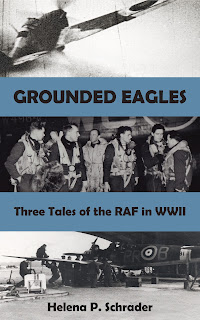The Last Commanders of 617: Tait and Fauquier
Altogether 617 Squadron had five COs, none lasting longer than eight months. It was tough job. Yet while Gibson was the most famous and Cheshire the most influential the last to COs nevertheless made significant contributions to the war. Here a short summary of their tenure with "the Dambusters."
In February 1941, Tait led the operation launched from Malta to drop paratroopers into Southern Italy and was awarded the DSO for his leadership. He was then posted as squadron commander now with the rank of squadron leader to 35 Squadron, which had just been equipped with Halifaxes. In this position he led a daylight raid against Kiel on 30 June 1941 for which he was awarded a second DSO.
In September 1941, he was finally taken off ops and sent to an assignment with Training Command, where he (along with other experienced pilots) was nevertheless asked to fly on Harris' early "thousand bomber" raids in early 1942. By mid-1942, he was back in command of a squadron, this time 78 Squadron, again flying Halifaxes. He was promoted to Wing Commander in the post.
In March 1944, he reverted temporarily to a non-flying job as Base Operations Officer at RAF Waddington, but in May of the same year he was appointed Master Bomber for 5 Group. In this role, he received this third DSO. It was from this position that he moved to 617 Squadron in July.
Initially, Tait led 617 in attacks against V1 and V2 launch sites using high-level, precision bombing with Wallis' Tallboy bombs, but it was for a low-level attack against the Kembs Barrage (a dam) that he led with determination in a damaged aircraft against fierce opposition that he earned his second DFC. Yet without doubt his most famous operations were those against the battleship Tirpitz. Altogether Tait led three raids against the Tirpitz, finally succeeding in sinking her on the third try.
In mid-December 1944, having completed 101 bombing sorties, Tait was forced to retire and was sent to train new crews. Although recommended for a VC for "sustained gallantry," the powers-that-be opted to give him a fourth DSO instead. Tait thus survived the war and remained in the RAF until his retirement in 1964.
John Emilius Fauquier was the only foreign commander of 617, coming from Canada and flying for the RCAF. Born in Ottawa, he first trained and earned a living as an investment banker, but the flying bug bit him and after obtaining a commercial flying license, he set up his own company providing ad hoc flying services in remote and otherwise inaccessible areas, commonly called "bush flying." Fauquier had already clocked more than 3,000 flying hours in this capacity before the Second World War broke out.
Fauquier immediately put his skills at the disposal of the Royal Canadian Air Force. He was commissioned as a flight lieutenant and assigned to train instructors for the Commonwealth Air Training Plan until mid-1941. Sent to the UK, he trained briefly at the glider and paratrooper center before being posted to No 405 Squadron RCAF. By February 1942, Fauquier had been promoted to acting wing commander and was in command of the squadron. He had also earned his DFC.
Shortly afterwards, however, he was taken off operations and given a staff job with the RCAF Overseas Headquarters and afterwards with 6 Group (RCAF). February 1943, however, found him back with 405 Squadron as CO again. He was deputy Master Bomber during the attack on the Wehrmacht's experimental rocket center at Peenemuende in August 1943. During this attack, he flew over the target a total of 17 times. He was awarded the DSO in September 1943 and promoted to Group Captain. Meanwhile, 205 Squadron had been moved to 8 Group (Pathfinders). In January 1944, after completing his second tour with 205 Squadron, he was promoted to air commodore and given a second DSO.
The rank of air commodore precluded any further operational flying, so he voluntarily reverted to the rank of Group Captain in order to take command of 617 Squadron in December 1944. It was under Fauquier's command that the squadron used Wallis' 20,000 lb "Grand Slam" bomb for the first time. In March they used these bombs to demolish the Bielefeld aqueduct. In addition, the squadron carried out attacked on the most hardened targets such as submarine and E-boat pens. One of its last raids used the Grand Slam bombs to penetrate some 20 feet of concrete before detonating inside a factory building U-boats that could travel faster underwater than most merchantmen did on the surface. 617's final operational sortie was against Hitler's "Eagle's Nest" at Berchtesgaden on April 25, 1944, but it also participated in the food drops to the starving population of Holland. Fauquier was awarded his third DSO for his command of 617 Squadron from December 1944 to May 1945.
For the greater part of the war, RAF Bomber Command was viewed by civilians and aircrew alike as the only means of striking back at Hitler for the damage, destruction and misery he had inflicted.
My novels about the RAF in WWII are intended as tributes to the men in the air and on the ground that made a victory in Europe against fascism possible.
Riding the icy, moonlit sky,
they took the war to Hitler.
Their chances of survival were less than fifty percent.
Their average age was 21.
This is the story of just one bomber pilot, his crew and the woman he loved.
It is intended as a tribute to them all.
or Barnes and Noble.

"Where Eagles Never Flew" was the the winner of a Hemingway Award for 20th Century Wartime Fiction and a Maincrest Media Award for Military Fiction. Find out more at: https://crossseaspress.com/where-eagles-never-flew
For more information about all my aviation books visit: https://www.helenapschrader.com/aviation.html








Comments
Post a Comment